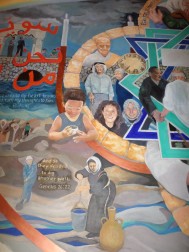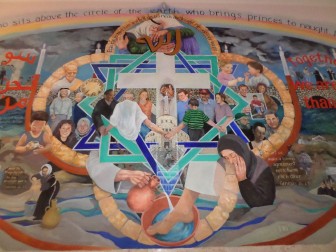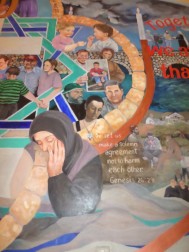"... Esau ran to meet him, and put
his arms around him, and they wept..."
Reconciliation: A space where mercy and forgiveness meet
Notes on the Mural of Forgiveness
by the Artist, Diane Roe



In the summer of 2000 I visited Ibillin and saw the opportunity to
paint a unique story of mercy and forgiveness on the wall of the yet to
be constructed Niwano Peace Auditorium. On October 2, 2000 at home in
New York I was stunned to hear of killing of Asel Asleh, an MEEI
student and 13 others in Galilee. When I rejoined my CPT (Christian
Peacemaker Teams) colleagues in Hebron one week later I found myself in
a war zone. The second Intifada had erupted. The images that burned
themselves into my heart as I divided my time between Galilee, Hebron
and the serene Finger Lakes region of New York became the figures in my
first sketches. The last three years have been times of immense and
terrible turmoil. The storm still rages but many people of Israel and
Palestine as well as from countries world-wide are transcending the
fury and creating beautiful new realities.
Many will remain unsung and unseen, but all are represented by the
faces you see before you in the mural. The scene has been greatly
shaped by my experience of living in Hebron and traveling back and
forth across the country to Galilee. I wanted to carry the friendship
and faces from Hebron to Galilee and from Galilee to Hebron. I want you
the people of Hebron to know that the children of Galilee know you and
care about you. It is my privilege to know all of you. Thank you Abuna
for trusting me to paint as I feel. I thank my CPT friends for
listening to my dream and allowing me to paint them. They are a
constant inspiration. I have prayed that this work will be a faithful
witness of the vision of future peace. Blessings to all of you and know
that I will return to see the vision unfolding and to hear many more of
your stories.
Dianne Roe
March, 2004
THE PEOPLE AND THE SYMBOLS
FOOTWASHING – The foundation of the mural is an image of humility
as the leader becomes the servant of the servant. Washing the feet of
another is a symbol of acceptance, forgiveness and love that transforms
all human relationships. We all stand in equality before the Servant
Creator.
RABBI SULIMAN MANI – Sephardic Rabbi in Hebron pre 1929. Elijah
Mani, his father, arrived in Hebron from Iraq in the early
1800’s. In recent years Hebron Palestinians have welcomed in
their midst Yona Rochlin, the great grand-daughter of Rabbi Mani. Yona
envisions a renewal of the peaceful relationships between the
descendants of Muslims and those of the Jews of pre 1929 Hebron.
YUESEF SHARABATI – late father of Hebronite Affifa Sharabati. The
Sharabati home was attacked many times by settlers and finally in July
2002 Affifa and her family were forced to leave their home. After the
final attack the IDF declared it a closed military zone. Affifa teaches
physics in a girls’ secondary school in Hebron. With Yona, she
prays for peace.
“TOGETHER WE ARE STRONGER THAN THE STORM” – Only
together, in accepting the diversity and difference of each other, can
we survive the storms of oppression, discrimination and dispossession.
The cycle of fear and violence, reaction and retaliation can be broken
but we must hold hands together, Jews and Arabs, Christians, Muslims
and Druze, in order to rebuild the broken relationships and wounded
hearts.
SHEFA – a grandmother from Bethany. She holds her newest
grandchild, Bashar, born in the spring of 2003. Shefa was a child when
her family were forced to flee from Haifa in 1948. Behind her Jesus
weeps over Jerusalem.
RONI HIRSHENZON – co-founder of The Parents’ Circle formed
to support Israeli and Palestinian families who have suffered the loss
of loved ones in the conflict. Roni has lost two sons. Amir was killed
by a suicide bomber. Five years later Elad committed suicide when
his best friend was killed by another suicide attacker.
IM NIDAL – also a member of the Parents’ Circle. Her son,
Nidal, was killed by Israeli soldiers in February 2002. He was at the
calling hours for his cousin who had been killed just days earlier also
by soldiers.
YUSEF BRIEGITH – named after his uncle who was killed in 2001,
Yusef holds the cup of reconciliation. His father, Ghazi, represents
the Palestinian families of The Parents’ Circle joining their
Israeli partners in a sign of forgiveness and peace.
HEBRON UNIVERSITY STUDENTS – in January 2003 their university was
closed by the Israeli military. Together with students from the nearby
Polytechnic they asked CPT members to accompany them as they organized
a non-violent initiative to reopen their university.
RABBIS FOR HUMAN RIGHTS – RHR, Ta’ayush, CPT and the
Palestinian Land Defense Committee (LCD) joined together to deliver
food and essential supplies to families in the southern Hebron
district. The families’ homes were demolished by the army in July
2001.
AMOS GVIRTZ – a founder of the Israeli Committee Against Home
Demolitions (ICADH) organized a group of Israelis and Internationals to
rebuild the destroyed wells of families in the South Hebron hills.
MARY – a young woman from Nazareth was “great with
child” when she traveled with her husband, Joseph down to
Bethlehem. Today on that same road Mary would pass through many dirt
barriers (machsomim) and check points. The women standing near the
checkpoint as Mary approaches are from the Israeli Machsom Watch. When
women and others are stopped by soldiers at the checkpoint, they try to
provide accompaniment and comfort for the women.
MICHAEL & KUTOUB CHACOUR – the parents of Father Elias
Chacour prepared to welcome Jewish refugees from war torn Europe to
their village. In the summer of 1947 when Jewish refugees were stranded
aboard the ship ‘Exodus’ in the Mediterranean, Palestinians
were forced from their homes to make way for them. Father
Chacour’s family were among those Palestinians who then became
refugees in their own land. Their lives stand as a testimony of hope in
the face of deep suffering.
BEIT ARABIYYA – In the summer of 2003, hundreds of
internationals with Jeff Halper joined Salim Shramweh in rebuilding his
destroyed home. The rebuilt structure, named Beit Arabiyya in honor of
Salim’s wife, is dedicated to all those killed in house
demolitions.
CITY OF PEACE - Jerusalem, Holy City for the believers of three
monotheistic religious traditions, is a place heavy with history and
profound meaning for all. Here a Muslim, a Christian and a Jew pray for
Jerusalem.
HORI KOSHI – a Japanese Buddhist monk who has walked for
peace throughout the Middle East. His drum bears an inscription praying
for world peace. The auditorium in which you stand was built with the
Peace Prize awarded to Father Chacour by the Niwano Peace Foundation, a
Buddhist organization in Japan.
YONATAN BEN ARTZI – the parents of refusenik, Yonatan, hold their
son dear as one who rejects violence in any form. He was imprisoned in
August 2002 as I began work on the mural. He remained in prison during
the two years I worked.
CELEBRATING – an Israeli child and a Palestinian child share food
together. In May 1999, they were at a party in ‘no man’s
land’, the strip of land that separates the Palestinian village,
Idna, from Israel. The children’s parents are members of the
Rehovoth branch of Peace Now and their partners, a dialogue group from
Idna and surrounding villages.
ANOTHER CELEBRATION – in April 2000 an Israeli court decision
allowed Palestinian shepherds of South Hebron to return to their cave
dwellings. To thank their international and Israeli friends who
supported them in the court action they gave a party. Hagar Roublev and
Liga celebrated together. A few month’s later as Hagar died of a
heart attack, Liga’s home was once again under threatened.
AN UNBROKEN CIRCLE – “To clasp hands in prayer is the
beginning of an uprising against the disorder of the world.”
(Karl Barth). The prayer circle forming the central focus of the mural
was inspired by my experience in a Hebron orchard. The owner, a farmer
from Beit Ummar, suffered the confiscation of his land as it was taken
for a security zone for a nearby settlement. Hundreds more farmers had
their land expropriated for the ‘security fence’ now being
constructed by the Israeli Government. A non violent resistance has
taken root in the prayer circle.
(clockwise from right of the Cross)
ASIL ASLEH – a twelfth grade student at MEEI, was killed by
soldiers on October2, 2000 as he watched a Land Day march in his home
village of Arrabe. Asil has been the guiding inspiration for the mural.
Although I never met him, his message of active reconciliation will
continue to inspire. The bridge spanning the mural reflects
Asel’s encouragement to his fellow students to be ‘ a stone
in the bridge of reconciliation’.
GEORGE WEBER – my team mate in CPT died in a car accident in Iraq
in January 2003. George was there to challenge the US
government’s policy in waging war on Iraq.
SMADAR ELHANAN – a young Jewish girl who wrote and spoke for
peace between Israelis and Palestinians. In 1997 at the age of
13, she was killed by a suicide bomber. Her parents continue her
message of peace through their action in The Parents’ Circle.
ASHRAF – a small boy in a striped shirt who lived by scavenging on the Yatta garbage dump for most of the summer of 2003.
MARTIN LUTHER KING Jr.
MAHATMA GHANDI
RACHEL CORY – a 20 year old American college student who
volunteered with the International Solidarity Movement (ISM). Her
strong sense of justice was outraged by the Israeli Army’s
actions in Gaza. She placed herself between a family home and the IDF
bulldozer. The bulldozer did not stop. Rachel was crushed.
SYMBOLS – both divide and unite, include and exclude. The prayer
circle contains and is contained within the intertwined Star of David,
Ottoman Star (an ancient symbol found on many mosques) and the Cross.
All three religious symbols are also reminders of the oppression of
empires and the domination of conquerors. Those who challenge the
systems of power, hegemony and injustice join hands in a circle of
prayer.
CHURCH OF THE SERMON ON THE MOUNT – the ultimate challenge
for Christians is to give their lives for those in need –
the anayim of the Gospels. The storms of life are great and it is
ordinary Christians who must ensure that the Light will always be a
sign of hope. On the steps of the Church we meet Father Chacour
and the little refugee dog, Mumkin that seeks only affection. The
children gather to greet to their uncle under the shadow of Ashraf the
boy from the garbage dump. Everyday trials and treasures are part of
each one’s life. Above all is the symbol of a hand always ready
to shield the fragile light of the candle from a threatening storm.
A FESTIVAL OF LIGHT – the Hanukkah Candelabrum is a symbol of the
Jewish celebration of high religious and human ideals. Those who
exemplify these ideals today are those who work for the human and civil
rights of all people. Near the branches of the candelabrum a women from
Machsom Watch, members of the Rabbis for Human Rights and other Jewish
human rights organizations. Their dedication keeps the flame of justice
and hope burning.
BLOOD BROTHERS – after years of bitter estrangement two brothers
met at the Jabbok river. Esau ran to greet his brother, embraced him
and kissed him. Each saw in the other the ‘face of
God’. Their embrace fuels the light of the rising flame of
the Christ candle and the central Hannukah candle. The holy name of God
– Allah in Arabic – entwines the embracing brothers.
These twin grand children of Abraham are a symbol of the hope we have
today for reconciliation between the ‘blood brothers’ of
this land that is holy for all Arabs and Jews.


